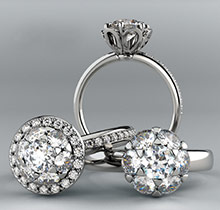As many as one in seven people have a metal allergy. This allergy to certain metals can make it difficult to find jewelry that doesn’t cause irritation or allergic reactions. Knowing which metals to avoid and which ones are hypoallergenic can make it easier to find fabulous pieces that won’t irritate your skin.
Many metals have added alloys that can cause reactions in sensitive skin. This contact dermatitis usually develops 24 to 48 hours after exposure and causes a red, swollen, itchy rash that can become dry, cracked or even develop blisters. The rash, which can vary from mild to severe, will appear where the jewelry was in contact with the skin, but can sometimes spread to other areas. Contact dermatitis will resolve after the jewelry is removed and avoided, but will reappear each time the skin is exposed to the allergen. Metal allergies may be present from childhood or they may develop over time. These allergies do not go away and the reactions may worsen with repeated exposure. In many cases, piercings trigger the allergies when the metal particles are exposed to the open wound.
There are a number of metals that can cause allergic reactions, but the primary metal allergen is nickel. Nickel oxidizes when it comes into contact with moisture, forming salts that then irritate the skin. Water, sweat, and even perfumes and lotions can cause nickel to oxidize. Copper and cobalt are also common metal allergens. Unfortunately these metal allergens are often mixed into metal alloys. Gold and silver are sometimes mixed with nickel and copper to make them harder and less expensive, but the inclusion of these metals can trigger allergic reactions. Also be wary of plated jewelry, which often has nickel under a layer of gold or another metal.
Even with metal allergies, it is still possible to find beautiful jewelry that won’t leave you miserable. Some great hypoallergenic options include:
14-karat gold or higher – Most gold alloys of 14-karat or more won’t cause reactions. Jewelry pieces that are lower than 14-karat usually contain nickel and other alloys that may cause allergic reactions. Also, avoid colored gold, such as rose gold, which uses copper to create the rosy tint. Some white gold alloys can still cause reactions due to the nickel that provides the silver coloring.
Palladium – Palladium is a great substitution for white gold. It replaces the rhodium and nickel in white gold, which can cause dermatitis. As an added benefit, palladium looks like platinum but is less expensive.
Platinum – Platinum is naturally hypoallergenic as it is usually comprised of less than 10 percent alloys.
Argentium sterling silver – Regular sterling silver contains an alloy, usually copper. Argentium sterling silver uses argentium as a hypoallergenic substitute for copper while still providing the same beautiful appearance.
Titanium – It is a highly durable and hypoallergenic metal. Some gold jewelry uses titanium alloys in place of nickel or other potential allergens.
Ceramic – High-tech ceramic is a synthetic material that is both durable and hypoallergenic. It is primarily used in rings and watches.
Tungsten – Tungsten is a hypoallergenic metal often used as an alloy for gold jewelry
Surgical-grade stainless steel – Surgical-grade stainless steel is highly recommended by jewelers for wires or posts on earrings. Be sure it says surgical or nickel free as regular stainless steel may contain nickel alloys.
Always check the materials in jewelry before purchasing. If in doubt, metal-testing kits are available. The jewelry experts at The Diamond World can also help you select hypoallergenic jewelry that won’t leave you itchy.


